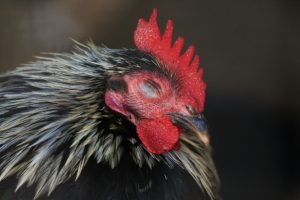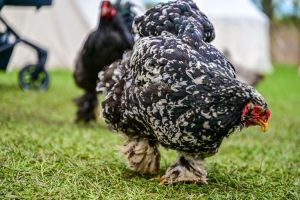Some chicken breeds can make everyone smile – from the littlest helpers to the grown-ups collecting their eggs. The secret to child-friendly chickens is choosing breeds that don’t get flustered when little hands want to help with feeding time or when excited voices announce the discovery of an egg.
These family-friendly breeds will reward you with plenty of eggs while being sweet-natured enough to become beloved backyard pets.
What Makes a Chicken Breed Child-Friendly?
Before you head to the farm store or hatchery, let’s talk about what makes some chickens better suited for life with children. The perfect family chicken has the following characteristics:
- Calm, docile temperament (as opposed to flighty or even agressive)
- Patient nature when handled
- Good size – large enough to be sturdy (which is important in the hands of a toddler!) but not overwhelming or too heavy
- Predictable behavior patterns
- Friendly disposition toward humans and other chickens – you wouldn’t want a child getting caught in the middle of a hen fight
Top Child-Friendly Chicken Breeds
Calm and Tolerant: Buff Orpington
Meet the Buff Orpington – a big, fluffy sweetheart that’s essentially a walking hug in chicken form. These golden-feathered beauties are famous for their calm, easy-going nature. Got a child who’s nervous around chickens? An Orpington will patiently stand still for beginning handlers and might even follow you around the garden like a friendly puppy.
Key characteristics:
- Weight: 3.6-4.5 kg (8-10 lbs)
- Egg production: 200-280 light brown eggs annually
- Temperature tolerance: Excellent in both cold and moderate climates
- Personality: Gentle, friendly, and easily tamed
Sweet layers: Australorp chickens
Australorps combine a sweet disposition with excellent egg-laying abilities, making them practical additions to any family flock. These birds tend to be curious but not overly energetic, creating safe interactions with children.
Key characteristics:
- Weight: 2.7-3.6 kg (6-8 lbs)
- Egg production: 250-300 light brown eggs annually
- Temperature tolerance: Good all-around adaptability
- Personality: Calm, friendly, and reliable
Fluffy and Small: Silkie Chickens
With their fluffy plumage and soft personalities, Silkies often become beloved family pets. These unique-looking chickens are smaller than standard breeds, making them less intimidating for young children. Their docile nature and inability to fly well means they’re easier to contain and handle.
Key characteristics:
- Weight: 1.5-2 kg (3.5-4.5 lbs)
- Egg production: 100-120 cream-colored eggs annually
- Temperature tolerance: Needs protection in extreme weather
- Personality: Exceptionally gentle and friendly
Friendly and Practical: Sussex Hens
Sussex chickens offer a perfect combination of friendly personality and practical benefits. These birds remain calm around children while maintaining good egg production, making them excellent dual-purpose additions to the family flock.
Key characteristics:
- Weight: 3.2-4.1 kg (7-9 lbs)
- Egg production: 240-260 light brown eggs annually
- Temperature tolerance: Good in most climates
- Personality: Docile, curious, and easy to handle
Curious and Gentle: Plymouth Rock (Barred Rock)
Plymouth Rocks, particularly the Barred variety, have earned their reputation as excellent family chickens through their consistent, gentle nature. These birds tend to be curious about human activity without becoming overly excitable.
Key characteristics:
- Weight: 3.4-4.3 kg (7.5-9.5 lbs)
- Egg production: 200-280 light brown eggs annually
- Temperature tolerance: Hardy in most conditions
- Personality: Calm, friendly, and adaptable
Creating Positive Interactions Between Children and Chickens
Even the sweetest chicken first needs to learn that tiny humans are friends, not scary giants! The good news is that chickens are quick learners, especially when treats are involved.
Start by showing your children how to be “chicken whisperers” – moving slowly and using quiet, happy voices around their feathered friends. It’s amazing how quickly chickens pick up on gentle behavior and start looking forward to their young caretakers’ visits.
Want to see some chicken magic? Set up regular treat times where the kids can be the bearers of good things, like scratch grains or mealworms. Before you know it, your chickens will be running over to greet their small friends at feeding time. Just remember to supervise these early friendship-building sessions – think of yourself as a chicken-child friendship coach, helping both sides learn to trust each other.
Setting Up Safe Spaces for your Hens
The right environment helps keep everyone safe and calm. A well-designed coop and run should provide plenty of space for chickens to move freely and retreat when they need quiet time. Setting up multiple feeding and watering stations prevents competition and keeps the flock calm during feeding times.
Dust bathing areas give chickens a place to relax and engage in natural behaviors, making them more content and easier to handle. Design the coop and run with safe observation points where children can watch the chickens without causing stress. This might include a designated viewing bench or a specific spot along the fence where chickens feel comfortable approaching.
Rooster or No Rooster?
While the breeds above are known for their gentle nature, a rooster’s job is to protect his flock from potential danger… and small children showing typical child behavior (running around, shouting and screaming, maybe even startling the chickens) might be perceived as a threat. And even the friendliest rooster may not harm your child, but could still try to get his hens into safety – potentially scaring a small child.
You don’t need a rooster for your chickens to lay eggs, so consider not adding a rooster to your flock until your children are older.
The above warnings aside, most families can easily keep a rooster with their chickens, with the rooster often becoming the children’s favorite. The trick is to always keep interactions between small children and chickens supervised, so you can stop kids before they start scaring the hens – and your rooster perceives them as their friend rather than a threat to the flock.
Health and Safety Considerations
A healthy flock creates better interactions for everyone involved. Following a consistent vaccination schedule and conducting regular health checks helps prevent issues before they arise. Clean living conditions not only keep chickens healthy but also make the experience more pleasant for children learning about chicken care.
Teaching proper hygiene practices should become part of the daily routine. Help children understand why they need to wash hands before and after handling chickens or collecting eggs. Make handwashing stations easily accessible and incorporate hygiene practices into the regular chicken care routine.
Getting Started
When introducing these breeds to your family:
- Start with 3-4 hens from one or two breeds
- Choose pullets or young hens for easier training
- Teach your children about chickens, including when to give them space
- Create opportunities for supervised interaction daily
Common Challenges and Solutions
Handling Shy Birds
Some chickens may start out timid, even from friendly breeds. Building trust takes time and consistency. Regular, gentle interaction with treats helps create positive associations, while calm handling helps build confidence over time. Shy birds often become more outgoing when they have a confident companion, so consider housing them with a more sociable chicken who can model calm behavior around humans.
Managing Different Age Groups
Different ages require different approaches to chicken interaction, and understanding these needs helps create successful experiences for everyone. Toddlers should always have close supervision and should only engage in gentle petting while sitting quietly with an adult. School-age children can take on more responsibility, starting with basic tasks like feeding and collecting eggs under supervision. As children demonstrate consistent careful behavior, they can gradually take on more involved daily care routines.
The key to success lies in matching responsibilities to each child’s maturity level and ability to follow safety guidelines. Some children naturally show more patience and gentleness, while others need more time to develop these skills. Adjust involvement based on individual readiness rather than age alone.
Making the Final Choice
Consider these factors when selecting your breeds:
- Available space in your coop and run
- Local climate conditions
- Egg production needs
- Children’s ages and maturity levels
The best child-friendly flock combines breeds that complement each other while maintaining a calm, friendly environment. Start with one or two breeds from this list, and adjust based on your family’s experience and needs.





0 Comments